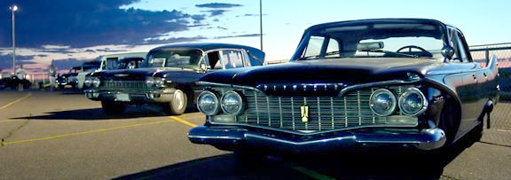Trailer queens. That’s what you call classic cars put on trailers and driven to car shows. They live in locked garages, Nan Morningstar says. "People buy antique cars as an investment and spend thousands making them beautiful." Neither Morningstar nor fellow mechanic and hot rod enthusiast Cletus Riedel build trailer queens. That’s why all five of the Morningstars’ family cars and their two motorcycles are daily drivers. That’s why Cletus Riedel put together the Hot Rod Rumble at the Albuquerque Dragway. He’s promoting the driving of vehicles. "At car shows, you walk around. The cars don’t move. But they’re actually pieces of machinery that work usually," he says. "I thought it’d be great to get a chance to drive them, and give everyone a chance to stretch their legs a little bit."Riedel’s always worked on cars. "My father played with cars. I’ve got a younger brother involved in drag racing." And he’s always loved older cars. Working on them is more nuanced than working on new vehicles, he says. Modern cars can be plugged into a computer that will tell you what’s wrong. "Older cars, you just got to pay attention. You got to listen to them a little," he says. "You’re very attached to an old car. You’ve got to feel it out a little bit, and sometimes hit it with a hammer. It’s just a very different way of thinking."When Riedel says old, he means old. He’s got a ’64 Ford Falcon that he calls a "little bit newer car." His daily driver is a 1936 Ford pickup. He can always find it in a parking lot, he says. "I have to practice what I preach. I think you should be able to drive them, so I tend to drive them." And he’s had to touch every bolt on it at least once. He’s also got a 1931 Ford coupe with five windows, a 1935 Ford two-door sedan, a 1949 Chevy pickup and a 1959 Volkswagen bus. "There’s probably some other stuff, but I’ll just leave it at that," he laughs. "They’re all in different states of whatever." Riedel quit his engineering job five years ago to open an auto shop in the North Valley. He collects parts, and when he has everything needs, he "puts something together." So which one is his favorite? "The … truck?" he hesitates. "Well, I’m standing in front of it, so I should probably tell it that it’s my favorite." A lot of hot-rodders gravitate to the early Fords, he says, and he prefers his Chevys a little newer. Riedel’s drawn to a historically significant period of hot rod, he says. Guys coming back from World War II bought ’32 roadsters. They would strip them down and remove the fenders in pursuit of speed. In that tradition, his truck doesn’t have fenders. "It’s open-wheeled. It’s louder than it should be. It’s meant to go fast. It’s not the most comfortable thing to spend time in." Morningstar’s in that camp, too. She’s got a 1977 Toyota Celica that has a fuel-injected 5.0 engine from a Mustang. "I don’t need my car to be pretty," she says. "I want it to be fun to drive." She and her husband John pull vehicles out of the junkyard or buy them out of people’s yards. A normal budget for a car, start to finish, is about $1,000. They’re true budget builds, she says. "We buy cars really cheap. People don’t know how to get them running. That’s our skill set."Morningstar was a kid when she saw her first classic car. "I didn’t know what it was, but I thought it was beautiful, and I wanted it. My dad told me we couldn’t have old cars because they were for rich people. That paused my interest in cars for more than a decade." Later in life, she left college to join an automotive tech program at a community college. It was a two-year program, and students could get a series of national certifications. There she met her soon-to-be husband. "It was liberating to go to tech school and get the skill set and the knowledge to learn how to do this on my budget and terms instead of it being a rich kids’ club."She worked in Honda and Nissan dealerships for years, but found it was a tough way to make a living, she says. "It’s hard on the body. Most of the guys I worked with had bad backs and arthritis in their 30s." Plus, it stole her fire for working on hot rod projects. Right now, the Morningstars own what Riedel would think of as newer cars: a 1960 Plymouth Belvedere, a 1960 Cadillac hearse, a 1976 Chrysler Cordoba that’s built to race on dirt circle tracks, and a 1963 Ford Falcon station wagon that will be done up tiki-style with bamboo and thatch in the interior.There’s a stark divide in the way male mechanics treat women in the field, Morningstar says. "I’ve found that trying to deal with men as someone who knows about cars—professionally or as a hobbyist—either they don’t trust you and think you don’t know what you’re talking about, or you’re like the cool daughter they never had." She was the only woman in auto school, but she says there are more and more. Plenty show up to the monthly Wrecks, Rods and Wrenches event on the last Saturday of every month at Free Radicals, the store the Morningstars own. People bring their projects down and get them ready to drive on the track or maybe just on the road. Mechanics and enthusiasts share their knowledge and wrench on their vehicles. "Anyone can do it," she says. "I can’t imagine driving a modern car."
Hot Rod RumbleAlbuquerque Dragway Saturday, May 22, 4 p.m. to midnight$10 for spectators, $15 for driversabqdragway.comDirectionsWrecks, Rods and WrenchesSaturday, May 29, 10 a.m to 8 p.m.Free Radicals, 300 Yale SE254-3764







